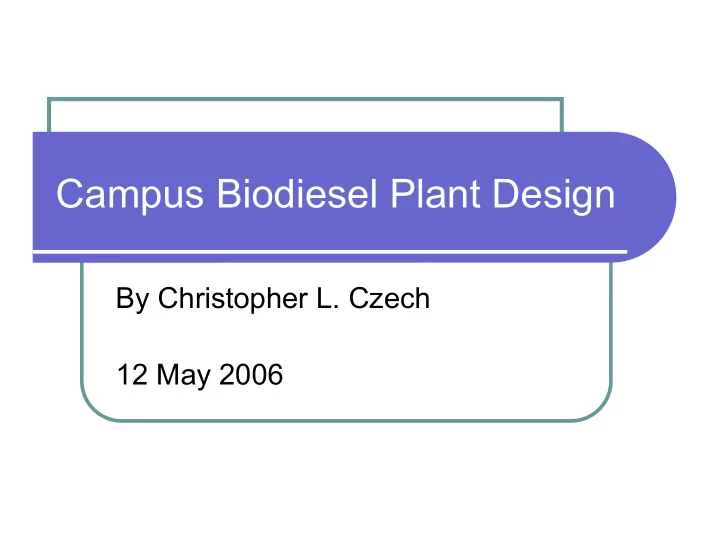

Campus Biodiesel Plant Design By Christopher L. Czech 12 May 2006
Overview � Objectives � Background Information � Alkali Catalyst Research � Reactor Mass Balance � Economic Considerations � Methanol Recovery � Uses of Glycerol
Objectives � Produce 100 gal/week of biodiesel � Used to run campus shuttle buses � Motivation for Plant � Combat rising prices of petroleum fuel � Reduce waste produced on campus by recycling � Educational Tool
Background Information � Transesterification of a vegetable oil was conducted as early as 1853 � Rudolf Diesel's prime model in 1900 was powered by peanut oil � 1990s biodiesel production begins in Europe
Background Information � Most plants are batch operation + ⎯ ⎯ ⎯ ⎯ → + + Triglyceri de 6 Methanol 3 Biodiesel Glycerol 3 Methanol ( Catalyst ) � 3 Types of Catalysts � Alkali � Acid � Enzyme
Alkali Catalyst � Most common catalyst type � NaOH or KOH � Shortest reaction time
Disadvantages of Alkali Catalysts � Highly hygroscopic � Less effective with a high concentration of free fatty acids
Advantages of Alkali Catalysts � The benefits of an alkali catalyst are: � Low temperature and pressure reaction � High conversion (up to 98%) � Quicker reaction time � No intermediate compounds � Relatively low materials and equipment costs
Reactor Mass Balance 371.9 moles oil 1673.6 moles biodiesel 1 2 0.33 MeOH 0.67 Biodiesel Reactor 2231.4 moles 929.8 moles 3 MeOH 4 0.6 MeOH 0.4 Glycerol
Economic Considerations � Cost of feedstock � Can effect biodiesel cost by up to 60%-75% � Want to produce a high-value co-product � Methanol recovery system
Methanol Recovery � Vacuum distillation � Assumed glycerol to be non-boiling � Important equations: 1582 . 271 ≡ = − * Antoine ' s log( P ) 8 . 08097 + T 239 . 726 ≡ = * Raoult ' s P * y P * x i i i ⎛ ⎞ • • dx W ∫ x ⎜ ⎟ = = Δ vap ln ⎜ ⎟ Q n v H − ⎝ ⎠ y x W x 0 0
Distillation Results � P * =295.5 mmHg � P Total =177.3 mmHg � Boiling Point of MeOH=43.3 ◦ C � Boiling Point Elevation=43.3 ◦ C – 109.5 ◦ C � Boiling Point of Glycerol= 252.34 ◦ C � Heat Duty=16208.22 BTU/hr
Concentration vs Time 0.7 0.6 Mole Fraction of Methanol in the Liquid Phase 0.5 0.4 0.3 0.2 0.1 0 0 10 20 30 40 50 60 Time
Temp vs Time 120 100 80 Temp (deg C) 60 40 20 0 0 10 20 30 40 50 60 Time
Temperature vs Concentration 120 100 80 Temperature (deg C) 60 40 20 0 0 0.1 0.2 0.3 0.4 0.5 0.6 0.7 Mole Fraction of Methanol in the Liquid Phase
Uses of Glycerol � De-icing agent � Pharmaceuticals � Cosmetics � Industrial Lubricant
Recommend
More recommend